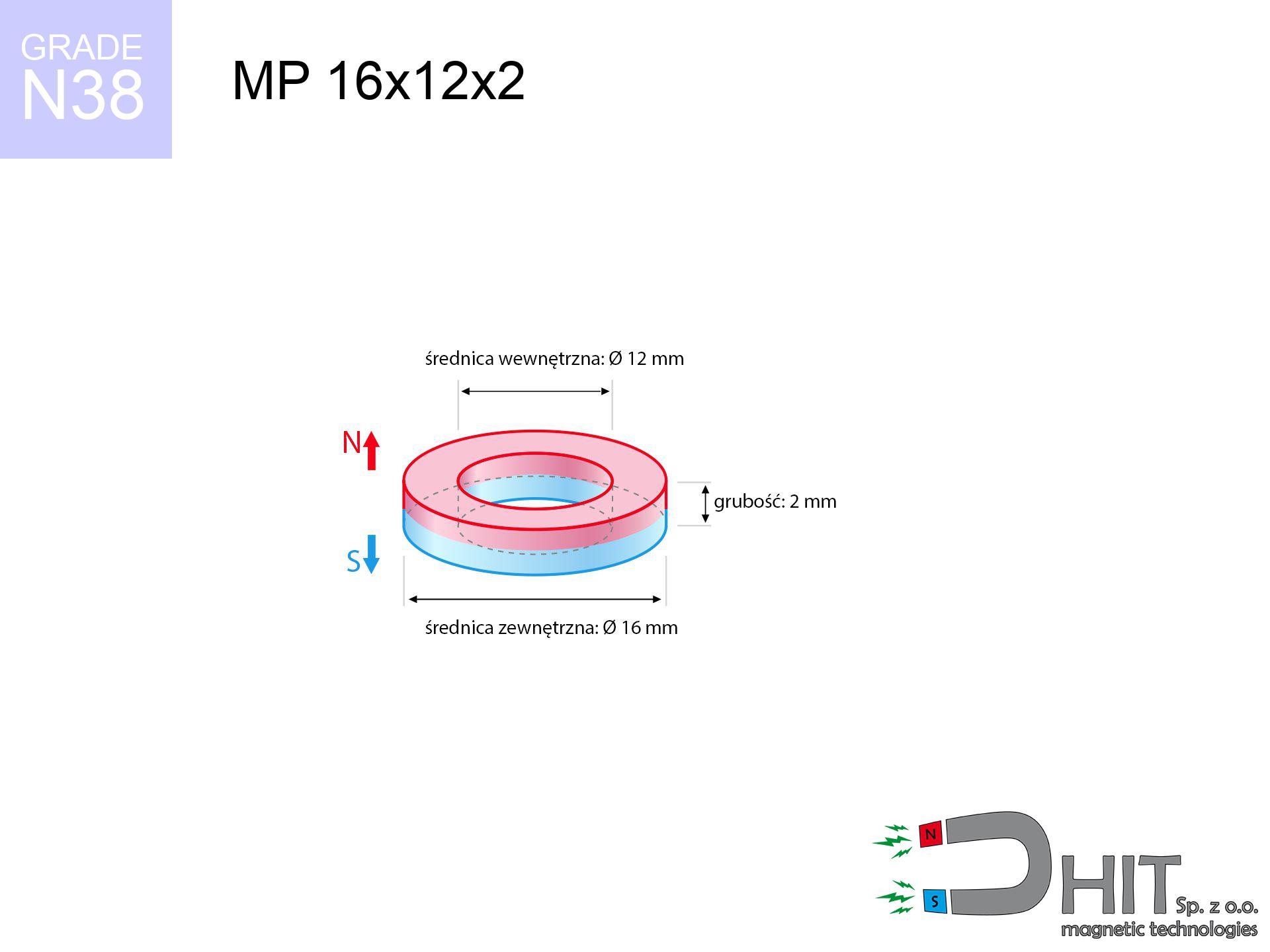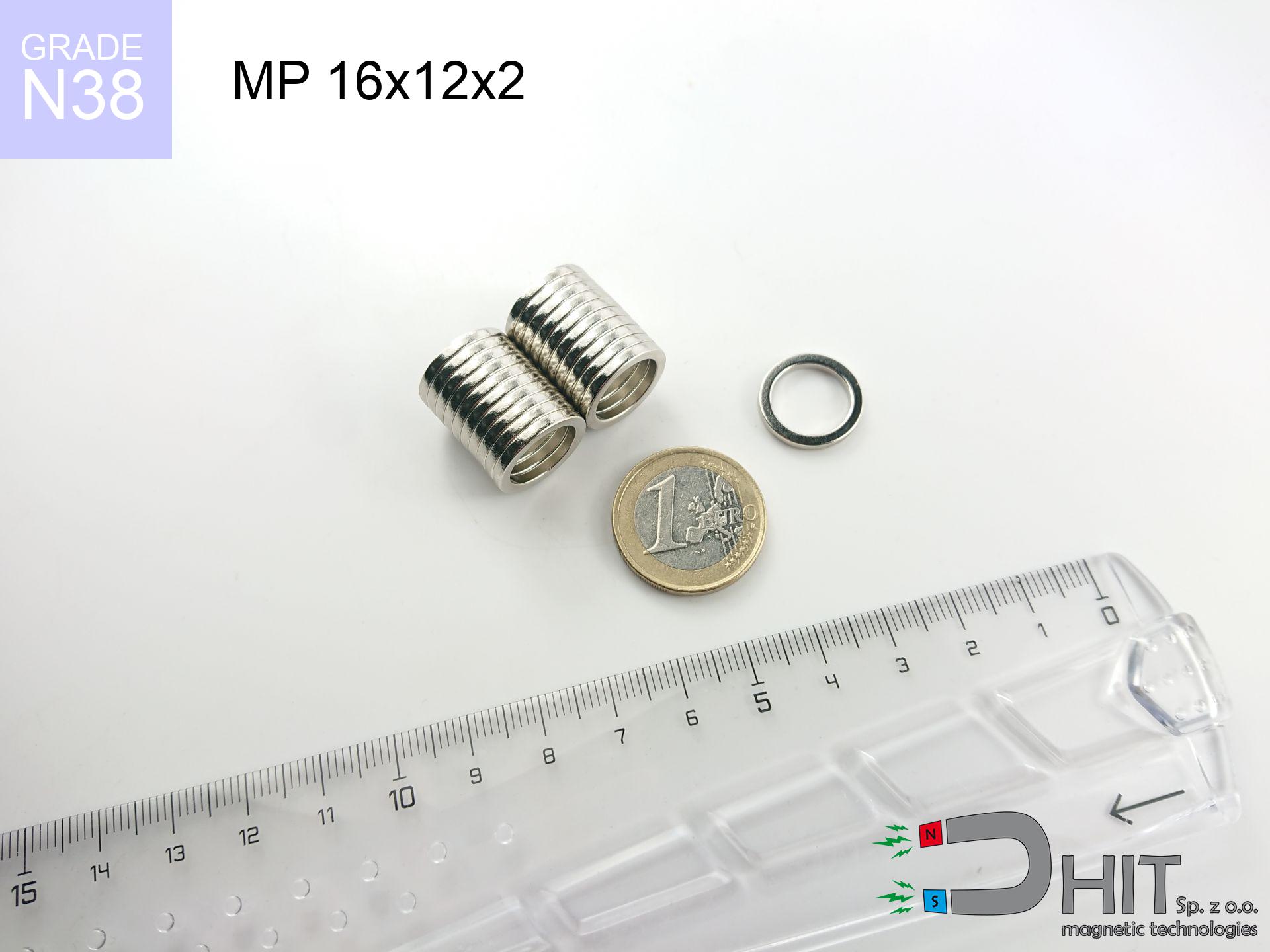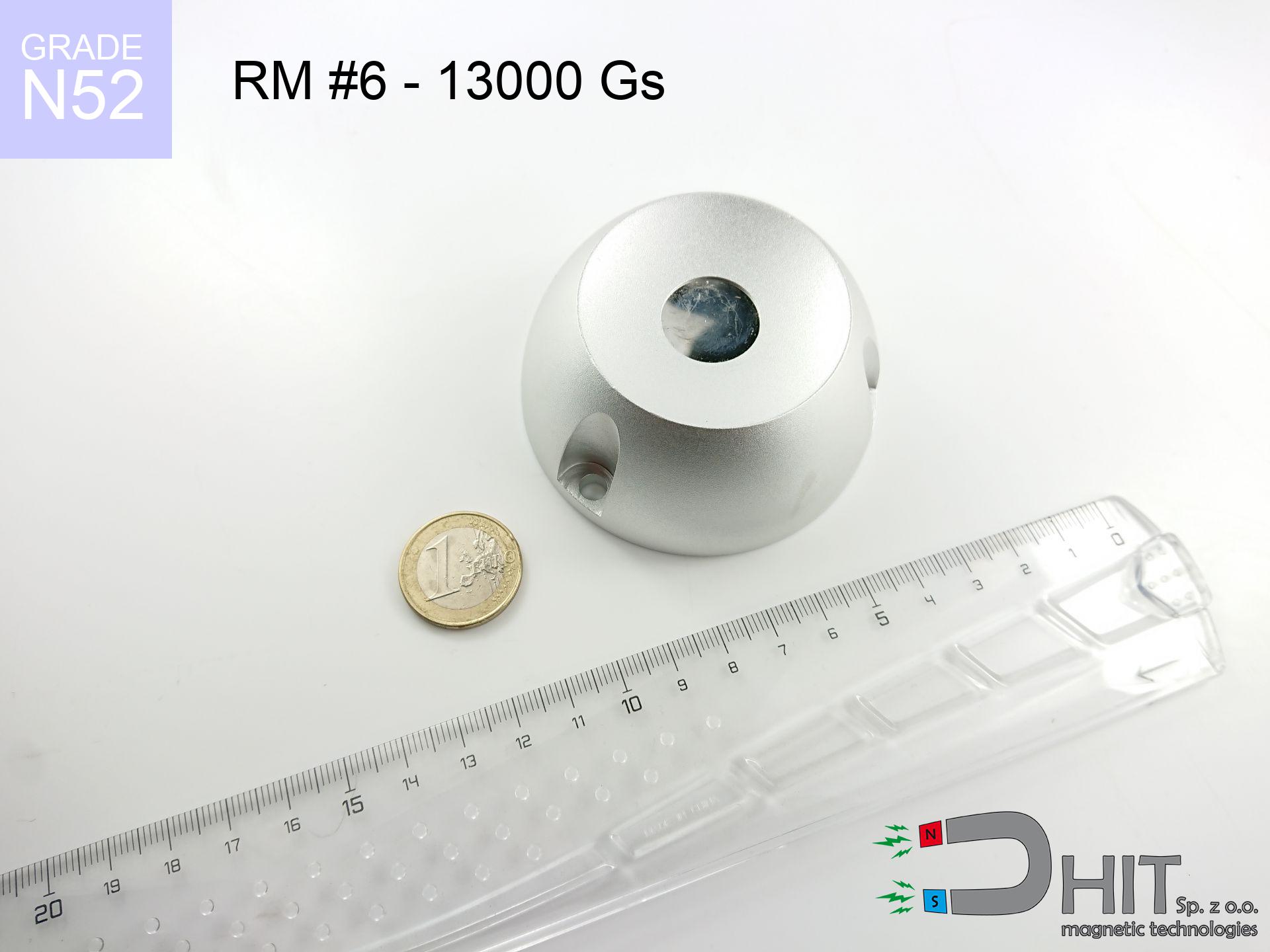MP 16x12x2 / N38 - ring magnet
ring magnet
Catalog no 030183
GTIN/EAN: 5906301812005
Diameter
16 mm [±0,1 mm]
internal diameter Ø
12 mm [±0,1 mm]
Height
2 mm [±0,1 mm]
Weight
1.32 g
Magnetization Direction
↑ axial
Load capacity
0.68 kg / 6.62 N
Magnetic Induction
150.33 mT / 1503 Gs
Coating
[NiCuNi] Nickel
1.304 ZŁ with VAT / pcs + price for transport
1.060 ZŁ net + 23% VAT / pcs
bulk discounts:
Need more?Hunting for a discount?
Contact us by phone
+48 888 99 98 98
alternatively drop us a message using
contact form
through our site.
Weight and form of neodymium magnets can be estimated on our
magnetic mass calculator.
Same-day shipping for orders placed before 14:00.
MP 16x12x2 / N38 - ring magnet
Specification / characteristics MP 16x12x2 / N38 - ring magnet
| properties | values |
|---|---|
| Cat. no. | 030183 |
| GTIN/EAN | 5906301812005 |
| Production/Distribution | Dhit sp. z o.o. |
| Country of origin | Poland / China / Germany |
| Customs code | 85059029 |
| Diameter | 16 mm [±0,1 mm] |
| internal diameter Ø | 12 mm [±0,1 mm] |
| Height | 2 mm [±0,1 mm] |
| Weight | 1.32 g |
| Magnetization Direction | ↑ axial |
| Load capacity ~ ? | 0.68 kg / 6.62 N |
| Magnetic Induction ~ ? | 150.33 mT / 1503 Gs |
| Coating | [NiCuNi] Nickel |
| Manufacturing Tolerance | ±0.1 mm |
Magnetic properties of material N38
| properties | values | units |
|---|---|---|
| remenance Br [min. - max.] ? | 12.2-12.6 | kGs |
| remenance Br [min. - max.] ? | 1220-1260 | mT |
| coercivity bHc ? | 10.8-11.5 | kOe |
| coercivity bHc ? | 860-915 | kA/m |
| actual internal force iHc | ≥ 12 | kOe |
| actual internal force iHc | ≥ 955 | kA/m |
| energy density [min. - max.] ? | 36-38 | BH max MGOe |
| energy density [min. - max.] ? | 287-303 | BH max KJ/m |
| max. temperature ? | ≤ 80 | °C |
Physical properties of sintered neodymium magnets Nd2Fe14B at 20°C
| properties | values | units |
|---|---|---|
| Vickers hardness | ≥550 | Hv |
| Density | ≥7.4 | g/cm3 |
| Curie Temperature TC | 312 - 380 | °C |
| Curie Temperature TF | 593 - 716 | °F |
| Specific resistance | 150 | μΩ⋅cm |
| Bending strength | 250 | MPa |
| Compressive strength | 1000~1100 | MPa |
| Thermal expansion parallel (∥) to orientation (M) | (3-4) x 10-6 | °C-1 |
| Thermal expansion perpendicular (⊥) to orientation (M) | -(1-3) x 10-6 | °C-1 |
| Young's modulus | 1.7 x 104 | kg/mm² |
Engineering modeling of the magnet - report
Presented information represent the outcome of a engineering simulation. Results were calculated on algorithms for the material Nd2Fe14B. Actual conditions might slightly differ from theoretical values. Treat these calculations as a preliminary roadmap during assembly planning.
MP 16x12x2 / N38
| Distance (mm) | Induction (Gauss) / mT | Pull Force (kg) | Risk Status |
|---|---|---|---|
| 0 mm |
6011 Gs
601.1 mT
|
0.68 kg / 680.0 g
6.7 N
|
low risk |
| 1 mm |
5259 Gs
525.9 mT
|
0.52 kg / 520.7 g
5.1 N
|
low risk |
| 2 mm |
4534 Gs
453.4 mT
|
0.39 kg / 387.0 g
3.8 N
|
low risk |
| 3 mm |
3870 Gs
387.0 mT
|
0.28 kg / 281.9 g
2.8 N
|
low risk |
| 5 mm |
2776 Gs
277.6 mT
|
0.15 kg / 145.1 g
1.4 N
|
low risk |
| 10 mm |
1251 Gs
125.1 mT
|
0.03 kg / 29.4 g
0.3 N
|
low risk |
| 15 mm |
643 Gs
64.3 mT
|
0.01 kg / 7.8 g
0.1 N
|
low risk |
| 20 mm |
372 Gs
37.2 mT
|
0.00 kg / 2.6 g
0.0 N
|
low risk |
| 30 mm |
159 Gs
15.9 mT
|
0.00 kg / 0.5 g
0.0 N
|
low risk |
| 50 mm |
49 Gs
4.9 mT
|
0.00 kg / 0.0 g
0.0 N
|
low risk |
MP 16x12x2 / N38
| Distance (mm) | Friction coefficient | Pull Force (kg) |
|---|---|---|
| 0 mm | Stal (~0.2) |
0.14 kg / 136.0 g
1.3 N
|
| 1 mm | Stal (~0.2) |
0.10 kg / 104.0 g
1.0 N
|
| 2 mm | Stal (~0.2) |
0.08 kg / 78.0 g
0.8 N
|
| 3 mm | Stal (~0.2) |
0.06 kg / 56.0 g
0.5 N
|
| 5 mm | Stal (~0.2) |
0.03 kg / 30.0 g
0.3 N
|
| 10 mm | Stal (~0.2) |
0.01 kg / 6.0 g
0.1 N
|
| 15 mm | Stal (~0.2) |
0.00 kg / 2.0 g
0.0 N
|
| 20 mm | Stal (~0.2) |
0.00 kg / 0.0 g
0.0 N
|
| 30 mm | Stal (~0.2) |
0.00 kg / 0.0 g
0.0 N
|
| 50 mm | Stal (~0.2) |
0.00 kg / 0.0 g
0.0 N
|
MP 16x12x2 / N38
| Surface type | Friction coefficient / % Mocy | Max load (kg) |
|---|---|---|
| Raw steel |
µ = 0.3
30% Nominalnej Siły
|
0.20 kg / 204.0 g
2.0 N
|
| Painted steel (standard) |
µ = 0.2
20% Nominalnej Siły
|
0.14 kg / 136.0 g
1.3 N
|
| Oily/slippery steel |
µ = 0.1
10% Nominalnej Siły
|
0.07 kg / 68.0 g
0.7 N
|
| Magnet with anti-slip rubber |
µ = 0.5
50% Nominalnej Siły
|
0.34 kg / 340.0 g
3.3 N
|
MP 16x12x2 / N38
| Steel thickness (mm) | % power | Real pull force (kg) |
|---|---|---|
| 0.5 mm |
|
0.07 kg / 68.0 g
0.7 N
|
| 1 mm |
|
0.17 kg / 170.0 g
1.7 N
|
| 2 mm |
|
0.34 kg / 340.0 g
3.3 N
|
| 5 mm |
|
0.68 kg / 680.0 g
6.7 N
|
| 10 mm |
|
0.68 kg / 680.0 g
6.7 N
|
MP 16x12x2 / N38
| Ambient temp. (°C) | Power loss | Remaining pull | Status |
|---|---|---|---|
| 20 °C | 0.0% |
0.68 kg / 680.0 g
6.7 N
|
OK |
| 40 °C | -2.2% |
0.67 kg / 665.0 g
6.5 N
|
OK |
| 60 °C | -4.4% |
0.65 kg / 650.1 g
6.4 N
|
OK |
| 80 °C | -6.6% |
0.64 kg / 635.1 g
6.2 N
|
|
| 100 °C | -28.8% |
0.48 kg / 484.2 g
4.7 N
|
MP 16x12x2 / N38
| Gap (mm) | Attraction (kg) (N-S) | Repulsion (kg) (N-N) |
|---|---|---|
| 0 mm |
37.47 kg / 37469 g
367.6 N
6 145 Gs
|
N/A |
| 1 mm |
32.95 kg / 32953 g
323.3 N
11 273 Gs
|
29.66 kg / 29657 g
290.9 N
~0 Gs
|
| 2 mm |
28.69 kg / 28690 g
281.4 N
10 519 Gs
|
25.82 kg / 25821 g
253.3 N
~0 Gs
|
| 3 mm |
24.81 kg / 24808 g
243.4 N
9 781 Gs
|
22.33 kg / 22327 g
219.0 N
~0 Gs
|
| 5 mm |
18.24 kg / 18235 g
178.9 N
8 386 Gs
|
16.41 kg / 16412 g
161.0 N
~0 Gs
|
| 10 mm |
7.99 kg / 7993 g
78.4 N
5 552 Gs
|
7.19 kg / 7194 g
70.6 N
~0 Gs
|
| 20 mm |
1.62 kg / 1622 g
15.9 N
2 501 Gs
|
1.46 kg / 1460 g
14.3 N
~0 Gs
|
| 50 mm |
0.06 kg / 57 g
0.6 N
471 Gs
|
0.05 kg / 52 g
0.5 N
~0 Gs
|
MP 16x12x2 / N38
| Object / Device | Limit (Gauss) / mT | Safe distance |
|---|---|---|
| Pacemaker | 5 Gs (0.5 mT) | 12.5 cm |
| Hearing aid | 10 Gs (1.0 mT) | 9.5 cm |
| Mechanical watch | 20 Gs (2.0 mT) | 7.5 cm |
| Mobile device | 40 Gs (4.0 mT) | 5.5 cm |
| Remote | 50 Gs (5.0 mT) | 5.0 cm |
| Payment card | 400 Gs (40.0 mT) | 2.0 cm |
| HDD hard drive | 600 Gs (60.0 mT) | 2.0 cm |
MP 16x12x2 / N38
| Start from (mm) | Speed (km/h) | Energy (J) | Predicted outcome |
|---|---|---|---|
| 10 mm |
23.50 km/h
(6.53 m/s)
|
0.03 J | |
| 30 mm |
39.66 km/h
(11.02 m/s)
|
0.08 J | |
| 50 mm |
51.19 km/h
(14.22 m/s)
|
0.13 J | |
| 100 mm |
72.39 km/h
(20.11 m/s)
|
0.27 J |
MP 16x12x2 / N38
| Technical parameter | Value / Description |
|---|---|
| Coating type | [NiCuNi] Nickel |
| Layer structure | Nickel - Copper - Nickel |
| Layer thickness | 10-20 µm |
| Salt spray test (SST) ? | 24 h |
| Recommended environment | Indoors only (dry) |
MP 16x12x2 / N38
| Parameter | Value | SI Unit / Description |
|---|---|---|
| Magnetic Flux | 11 219 Mx | 112.2 µWb |
| Pc Coefficient | 1.22 | High (Stable) |
MP 16x12x2 / N38
| Environment | Effective steel pull | Effect |
|---|---|---|
| Air (land) | 0.68 kg | Standard |
| Water (riverbed) |
0.78 kg
(+0.10 kg Buoyancy gain)
|
+14.5% |
1. Wall mount (shear)
*Caution: On a vertical wall, the magnet retains only a fraction of its perpendicular strength.
2. Steel saturation
*Thin metal sheet (e.g. 0.5mm PC case) drastically limits the holding force.
3. Thermal stability
*For N38 grade, the safety limit is 80°C.
4. Demagnetization curve and operating point (B-H)
chart generated for the permeance coefficient Pc (Permeance Coefficient) = 1.22
This simulation demonstrates the magnetic stability of the selected magnet under specific geometric conditions. The solid red line represents the demagnetization curve (material potential), while the dashed blue line is the load line based on the magnet's geometry. The Pc (Permeance Coefficient), also known as the load line slope, is a dimensionless value that describes the relationship between the magnet's shape and its magnetic stability. The intersection of these two lines (the black dot) is the operating point — it determines the actual magnetic flux density generated by the magnet in this specific configuration. A higher Pc value means the magnet is more 'slender' (tall relative to its area), resulting in a higher operating point and better resistance to irreversible demagnetization caused by external fields or temperature. A value of 0.42 is relatively low (typical for flat magnets), meaning the operating point is closer to the 'knee' of the curve — caution is advised when operating at temperatures near the maximum limit to avoid strength loss.
Elemental analysis
| iron (Fe) | 64% – 68% |
| neodymium (Nd) | 29% – 32% |
| boron (B) | 1.1% – 1.2% |
| dysprosium (Dy) | 0.5% – 2.0% |
| coating (Ni-Cu-Ni) | < 0.05% |
Sustainability
| recyclability (EoL) | 100% |
| recycled raw materials | ~10% (pre-cons) |
| carbon footprint | low / zredukowany |
| waste code (EWC) | 16 02 16 |
Other offers
Strengths as well as weaknesses of Nd2Fe14B magnets.
Pros
- Their magnetic field is durable, and after around ten years it drops only by ~1% (theoretically),
- Neodymium magnets are remarkably resistant to loss of magnetic properties caused by magnetic disturbances,
- A magnet with a smooth silver surface has better aesthetics,
- The surface of neodymium magnets generates a strong magnetic field – this is one of their assets,
- Thanks to resistance to high temperature, they are capable of working (depending on the shape) even at temperatures up to 230°C and higher...
- Possibility of detailed machining as well as adjusting to atypical requirements,
- Versatile presence in high-tech industry – they are commonly used in hard drives, motor assemblies, advanced medical instruments, as well as multitasking production systems.
- Thanks to concentrated force, small magnets offer high operating force, occupying minimum space,
Limitations
- To avoid cracks under impact, we recommend using special steel holders. Such a solution protects the magnet and simultaneously improves its durability.
- We warn that neodymium magnets can reduce their power at high temperatures. To prevent this, we advise our specialized [AH] magnets, which work effectively even at 230°C.
- They rust in a humid environment - during use outdoors we recommend using waterproof magnets e.g. in rubber, plastic
- Due to limitations in producing nuts and complicated shapes in magnets, we recommend using casing - magnetic mechanism.
- Potential hazard to health – tiny shards of magnets pose a threat, if swallowed, which is particularly important in the aspect of protecting the youngest. It is also worth noting that tiny parts of these magnets can complicate diagnosis medical after entering the body.
- High unit price – neodymium magnets are more expensive than other types of magnets (e.g. ferrite), which hinders application in large quantities
Holding force characteristics
Detachment force of the magnet in optimal conditions – what it depends on?
- with the contact of a yoke made of low-carbon steel, guaranteeing full magnetic saturation
- whose transverse dimension equals approx. 10 mm
- characterized by lack of roughness
- without any insulating layer between the magnet and steel
- during pulling in a direction perpendicular to the mounting surface
- at room temperature
Determinants of practical lifting force of a magnet
- Gap between magnet and steel – even a fraction of a millimeter of distance (caused e.g. by varnish or dirt) drastically reduces the pulling force, often by half at just 0.5 mm.
- Force direction – catalog parameter refers to pulling vertically. When attempting to slide, the magnet holds significantly lower power (often approx. 20-30% of nominal force).
- Base massiveness – too thin plate causes magnetic saturation, causing part of the flux to be escaped to the other side.
- Material composition – not every steel attracts identically. High carbon content worsen the interaction with the magnet.
- Plate texture – ground elements guarantee perfect abutment, which improves force. Rough surfaces reduce efficiency.
- Thermal conditions – neodymium magnets have a negative temperature coefficient. At higher temperatures they are weaker, and in frost gain strength (up to a certain limit).
Holding force was checked on the plate surface of 20 mm thickness, when the force acted perpendicularly, whereas under parallel forces the holding force is lower. In addition, even a minimal clearance between the magnet’s surface and the plate lowers the lifting capacity.
Medical interference
Medical warning: Strong magnets can deactivate heart devices and defibrillators. Do not approach if you have electronic implants.
Electronic hazard
Data protection: Strong magnets can ruin data carriers and delicate electronics (heart implants, hearing aids, timepieces).
Eye protection
Protect your eyes. Magnets can fracture upon violent connection, launching shards into the air. Wear goggles.
Crushing risk
Big blocks can break fingers in a fraction of a second. Under no circumstances put your hand betwixt two attracting surfaces.
No play value
Product intended for adults. Tiny parts can be swallowed, causing serious injuries. Keep away from kids and pets.
Maximum temperature
Do not overheat. Neodymium magnets are susceptible to temperature. If you need resistance above 80°C, ask us about HT versions (H, SH, UH).
Handling rules
Use magnets consciously. Their powerful strength can shock even experienced users. Stay alert and respect their power.
Do not drill into magnets
Combustion risk: Neodymium dust is explosive. Avoid machining magnets in home conditions as this may cause fire.
Sensitization to coating
Nickel alert: The nickel-copper-nickel coating consists of nickel. If redness occurs, cease handling magnets and use protective gear.
Impact on smartphones
Navigation devices and mobile phones are highly susceptible to magnetism. Close proximity with a powerful NdFeB magnet can decalibrate the sensors in your phone.




![SM 32x325 [2xM8] / N42 - magnetic separator SM 32x325 [2xM8] / N42 - magnetic separator](https://cdn3.dhit.pl/graphics/products/sm-32x325-2xm8-fog.jpg)


![SM 32x275 [2xM8] / N42 - magnetic separator SM 32x275 [2xM8] / N42 - magnetic separator](https://cdn3.dhit.pl/graphics/products/sm-32x275-2xm8-hac.jpg)

